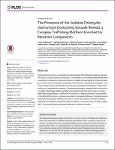The Proteome of the Isolated Chlamydia trachomatis Containing Vacuole Reveals a Complex Trafficking Platform Enriched for Retromer Components
Aeberhard, Lukas
Banhart, Sebastian
Fischer, Martina
Jehmlich, Nico
Rose, Laura
Koch, Sophia
Laue, Michael
Renard, Bernhard Y.
Schmidt, Frank
Heuer, Dagmar
Chlamydia trachomatis is an important human pathogen that replicates inside the infected host cell in a unique vacuole, the inclusion. The formation of this intracellular bacterial niche is essential for productive Chlamydia infections. Despite its importance for Chlamydia biology, a holistic view on the protein composition of the inclusion, including its membrane, is currently missing. Here we describe the host cell-derived proteome of isolated C. trachomatis inclusions by quantitative proteomics. Computational analysis indicated that the inclusion is a complex intracellular trafficking platform that interacts with host cells’ antero- and retrograde trafficking pathways. Furthermore, the inclusion is highly enriched for sorting nexins of the SNX-BAR retromer, a complex essential for retrograde trafficking. Functional studies showed that in particular, SNX5 controls the C. trachomatis infection and that retrograde trafficking is essential for infectious progeny formation. In summary, these findings suggest that C. trachomatis hijacks retrograde pathways for effective infection.
Dateien zu dieser Publikation
Keine Lizenzangabe

